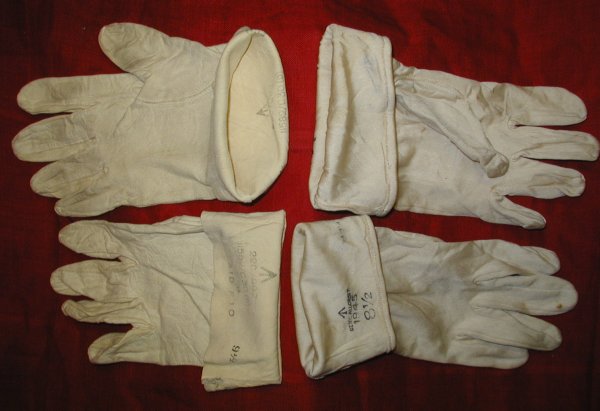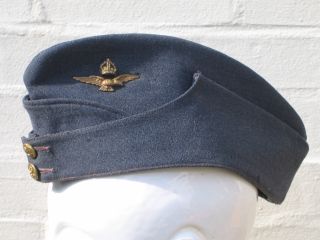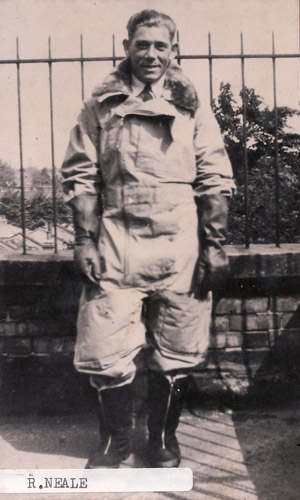Very nice. Just some small corrections, if you feel it's important to change.
The belt buckle on the RAF tunic is wrong it should be more like lower pictures.
I assume your version is based on the Osprey men at arms picture on page 4. It should be noted that this is not the tunic belt but a webbing belt (the same as on the front cover, but without pistol holster etc.) used in this instance to attach the holder for a bayonet. Also note eagles on shoulders.
The peaked cap is also wrong in this instance. Peaked caps were very rarely worn, if ever, except by commissioned officers (pilot Officer and above) except when on special parades or if attached to the camp guard, side caps were the normal head dress. The peaked cap you have shown is for junior ranks (below commissioned Officer, so rarely worn) as it has a black polished leather peak but you have shown it with an Officers cap badge (the crown on the badge is also wrong, as pointed out in a different post). Although the Officers hat is slightly different in shape, to make it look more correct simply change the colour of the peak to same as the top and make sure it is not attached to anyone below the rank of Pilot Officer.
Junior ranks peaked cap (note badge)

Commissioned Officers peaked cap (note badge)

The face mask would not be worn except with helmet, there would be no way to attach it or listen to the radio (this isn't Memphis Belle). The colour of the helmet should also be the same as the Irvin jacket or slightly darker but definitely brown rather than black.
This is a good example for colour

Although they often look darker if new, or very old.

WWII FLYING HELMET TYPE "B" MASK TYPE "D" and RCAF GOGGLES, 1940
N.B Oxygen tube connector
Helmet Mask and Goggles used during the Battle of Britain by RAF crews. The helmet was made by I.Compton & Sons & Webb Ltd .
Mk3 RCAF Goggles. 1935 Royal Canadian Air Force Type
Introduced around 1935 Mk3 Goggles used curved celluloid lenses fitted into narrow blackened metal frames with velveteen cushions and large leather surrounds intended to protect the wearer from the elements (most RAF fighter aircraft in service in the mid-1930's were still in open cockpits). these were superseded by the Mk4 version as the the Mk3's strap fouled on the earpieces of the type 'B' helmet. the Mk4 is far more likely to have been used during the Battle of Britain.
http://www.historicflyingclothing.com/archive.php

Gloves worn, as far as I am aware, would either have been, Gauntlets, generally worn with flying overalls or tunic.


or cream coloured flying gloves used in conjunction with the leather Irvin jacket. ( however normally somewhat dirty)

The gloves you show are not flying gloves but COMMISSIONED OFFICERS gloves to be worn on parade or during cold weather normally in conjunction with a great coat or blue tunic, but not for flying. Junior ranks would probably have worn black leather or blue/grey wool gloves.
The side cap. RAF pilots were not common Russian peasant soldiers but image concious/stylish Fighter Pilots, caps were worn at an angle, the general rule being as far as gravity and the Station warrant officer (GOD)would allow. The front should be no higher than the distance of the man's thumb tip to the first knuckle joint above the airman's eyebrow. The button holes for the two front brass buttons should not be edged with yellow/gold thread. It should also have a cap badge as in this picture.
Junior ranks

Commissioned Officers


The Sargent pilots uniform: It looks as if you have also given him the rank of a Pilot Officer , there should be no blue and black stripe around the cuff of the sleeve. The Sargent's stripes should also be larger, and the shoulder flash smaller. (note also belt buckle).


Lastly

The sheepskin trousers would not have been worn at this stage of the war as Irvin jacket were still a private purchase rather than standard issue (mostly by officers who had the money, but not exclusively) They may have been worn by Aircrew doing duties that exposed them to extreme temperatures but were not used in any quantity until later in the war when they were widely issued to Bomber crews flying at night, at altitude over occupied Europe.

Just realized the aircrew man in flying overalls is supposed to be RAF, what's with the handbag ? I can already hear the shouting and curses as Aircrew try to clamber through the tight confines of an aircraft with that bag catching on every possible object. If it supposed to be a charts/map case then a canvas brief case would have been more usual. I thought originally he was Luftwaffe, see picture of flying overalls (Sidcot, fur collar is detachable )for better representation. Some pilots however wore flying dungarees, more so in hot weather, Air Vice Marshal Keith Park was famous for his white flying dungarees.

N.B Above pic is NOT Sir Keith Park

Links:
http://images.google.co.uk/imgres?imgurl=http://www.blitzandpeaces.co.uk/Museum/WW2%2520Militaria/WW2%2520RAF%2520PHOTOS/thumbs/BRITISH%2520RAF%2520WARRANT%2520OFFICERS%2520PEAKE D%2520HAT%2520WITH%2520METAL%2520BADGE%2520FRONT.j pg&imgrefurl=http://www.blitzandpeaces.co.uk/Museum/WW2%2520Militaria/WW2%2520RAF%2520PHOTOS/main.asp&usg=__lJNmPH2cgy1A6UA5uEETNHJrRXA=&h=180& w=180&sz=9&hl=en&start=107&um=1&itbs=1&tbnid=NbbHt ztj5_gvmM:&tbnh=101&tbnw=101&prev=/images%3Fq%3Draf%2Bhats%26ndsp%3D21%26hl%3Den%26cl ient%3Dfirefox-a%26rls%3Dorg.mozilla:en-GB fficial%26sa%3DN%26start%3D105%26um%3D1
fficial%26sa%3DN%26start%3D105%26um%3D1